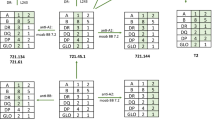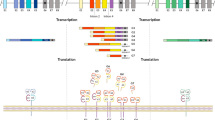Abstract
We have further developed the mouse model of Lyme disease using B10 H-2 congenic and recombinant strains. The influence of MHC class I and class II genes of the mouse H-2 complex on the susceptibility and/or resistance to Lyme disease was studied. We report that B10 strains congenic to the haplotypes, H-2k, H-2d, H-2f, H-2q, and H-2b are highly susceptible to Lyme disease as they develop high antibody titers and severe disease over mice of other haplotypes used in this study. By using recombinant strains we demonstrate that this susceptibility is genetically based and specifically involves the K and D regions (MHC class I genes) and I-A and I-E regions (MHC class II genes) of the H-2 complex.
Similar content being viewed by others
References
Buchwald A (1883) Ein fall von diffuser idiopathischer hautatrophie. Arch derm syph (Berlin) 15:553–556.
Afzelius A (1921) Erythema chronicum migrans. Acta Derm Venereal 2:120–125.
Lipschutz B (1913) Uber eine settene erytheform (erythema chronicum migrans). Arch Dermatol 118:349–356.
Garin C, Bujadoux (1922) Paralysie pae les Tiques. J Med Lyon 71:765–767.
Bannwarth A (1941) Chronische lymphocytare meningitis entzundliche polyneuritis and “Rheumatismus” eing beitrag zum problem “Allergic and Nervensystem.” Arch Psychiatr Nervenkr 113:284–376.
Bannwarth A (1944) Zur klinik und pathogenese der “chronischen lymphocytaire meningitis.” Arch Psychiatr Nervenkr 117:682–716.
Steere AC, Malawista SE, Snydman DR, et al (1977) Lyme arthritis: An epidemic of aligoarticular arthritis in children and adults in three Connecticut communities. Arthritis Rheum 20:7.
Steere AC, Malawista SE, Hardin JA, et al (1977) Erythema chronicum migrans and Lyme arthritis: The enlarging clinical spectrum. Ann Intern Med 86:685–698.
Johnson RC, Schmid GP, Hyde FW, et al (1984)Borrelia burgdorferi sp. nov: Etiological agent of Lyme disease. Int J Syst Bac 34:496–497.
Steere AC, Grodzicki RL, Kornblatt AN, et al (1983) The spirochetal etiology of Lyme disease. N Engl J Med 308:773–740.
Steere AC, Malawista SE (1979) Cases of Lyme disease in the United States: Locations correlated with distribution ofIxodes dammini. Ann Intern Med 91:730–733.
Burgdorfer W, Lane RS, Barbour AG, et al (1985) The western black-legged tickIxodes pacificus: A vector ofBorrelia burgdorferi. Am J Trop Med Hyg 34:925–930.
Dekonenko EJ, Steere AC, Beraudi VP, et al (1988) Lyme borreliosis in the Soviet Union: A co-operative US-USSR report. J Infect Dis 158:748–753.
Schulze TL, Bowen GS, Bolser EM, et al (1988)Amblyyomma americanum: A potential vector of Lyme disease in New Jersey. Science 224:601–603.
Steere AC (1988) Pathogenesis of Lyme arthritis. Ann NY Acad Sci 539:87–92.
Finn AF, Dattwyler MD (1990) The immunology of Lyme borreliosis. Lab Med 21(5):305–309.
Klein J, Figueroa F, Klein D (1982) H-2 haplotypes, genes, and antigens: Second listing. Immunogenetics 16:285–317.
Johnson RC, Schmid GP, Hyde FW, et al (1984) Borrelia burgdorferi sp. nov: Etiological agent of Lyme disease. Int J Syst Bact 34:496–497.
Thompson SW (1966) Modified Warthin-Starry method for the demonstration of spirochetes. In: Selected Histochemical and Histopathological Methods. Charles C. Thomas: Springfield, IL.
Clague RB, Shaw MJ, Holt L (1980) Incidence of serum antibodies to native Type I and Type II collagen in patients with inflammatory arthritis. Ann Rheum Dis 39:201–206.
Hill A, Allsopp C, Kwiatkowski D, et al (1991) Common West African HLA antigens are associated with protection from severe malaria. Nature 352:595–600.
Barthold SW, Beck DS (1990) Lyme borreliosis in selected strains and ages of laboratory mice. J Inf Dis 162:133–138.
Craft JE, Fischer DK, Shimamato GT, et al (1986) Antigen ofBorrelia burgdorferi recognized during Lyme disease. J Clin Invest 78:934–939.
Wooley PH, Luthra HS, Lafuse WP, et al (1985) Type II collagen-induced arthritis in mice. J Immunol 134(4):2366–2374.
Statsny P (1978) Association of the B-cell alloantigen DRw4 with rheumatoid arthritis. N Engl J Med 298:869–871.
Wernet D (1982) Genetic regulation of the antibody response to H-2Db alloantigens in mice. Immunogenetics 16:71–81.
Schaible UE, Kramer MD, Wallich R, et al (1991) ExperimentalBorrelia burgdorferi infection in inbred mouse strains: Antibody response and association of H-2 genes with resistance and susceptibility to development of arthritis. Eur J Immunol 21:2397–2405.
Author information
Authors and Affiliations
About this article
Cite this article
Reddy, S., Young, C.R., Hokanson, R. et al. The role of MHC class I and class II molecules in susceptibility to Lyme disease in inbred B10 H-2 congenic and recombinant mice. International Journal of Angiology 4, 88–93 (1995). https://doi.org/10.1007/BF02043624
Issue Date:
DOI: https://doi.org/10.1007/BF02043624




